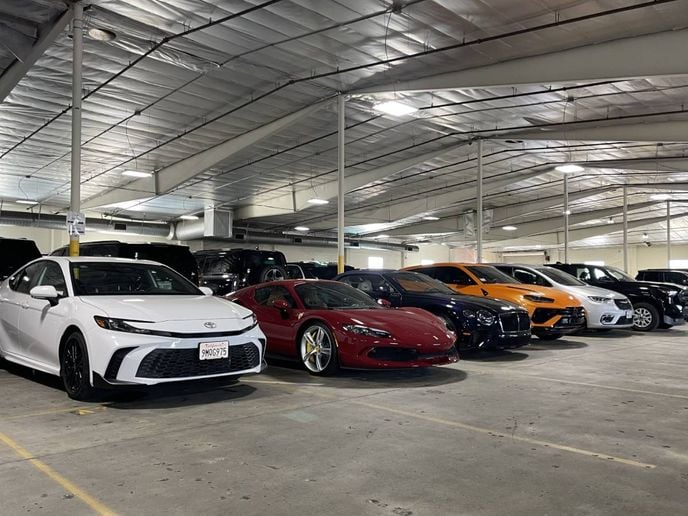
Rental fleet operators address how they fared in the fleet vehicle purchasing market in 2024.
Photo: Midway Car Rental
2025 marks the midpoint of an active decade redefined by that once-in-a-lifetime black swan event everyone may try to forget but lingers in the collective vocabulary.
For public-facing, service-driven business sectors such as auto rental, the after-era brings returns to normal mixed in with forever changes and prolonged uncertainties.
In this Part 1 of the Operator Outlook series from the 2025 Auto Rental News Fact Book, the interviewees answered three key questions:
- How would you assess fleet availability so far this year?
- What rental fleet vehicles are easier or harder to get?
- What is the state of fleet incentives and vehicle pricing for your company?
Fleet Availability and Acquisition
It all starts with what rental vehicles you can get when, and how much they cost.
Kolodziej has seen consistent improvement in the availability of rental fleet vehicles during the last two years.
“Overall, there’s more supply in the market. Some automakers are cutting production, others are transitioning to more hybrids, a few automakers have a lot of inventory on the ground while adjusting prices and incentives, and still others are more disciplined with discounting and incentives,” Kolodziej said in a September ARN interview. “The real question will be what happens to supply and residuals in the used car market later depending on OEM supply and production controls today.”
Hemmert described the rental fleet market as more of a “normal insanity.”
“From the beginning of this model year, 2024 was a green light across the board,” Hemmert said, referring to Asian and European brands. “It is amazing how quick we can forget about the pains of the past,” he said. “Business today has brought everyone back to where it was before.”
Fathi is noticing more negative incentives: Some OEMs are decreasing prices while increasing incentives, in another sign that the rental fleet market is back to a pre-pandemic normal. Overall, domestic manufacturers are doling out more incentives than Asian-based ones, he said.
NextCars’ corporate operation has benefited from plenty of new vehicles, some of which are priced only $2,000 to $3,000 above used cars. The company has been buying more used vehicles, but the supply has been lower lately. “New fleet days’ supply is climbing to a better level with more new car incentives that are normalizing the traditional automotive market.”
At Wallschlaeger’s operation, new fleet vehicle availability has been limited. Since the pandemic, OEMs overall have been manufacturing fewer vehicles than pre-2020. With consumer demand for new vehicles rising, OEMs don’t need to sell as many vehicles into the fleet sectors, he said. Supply chains and production vary among auto manufacturers, resulting in different days’ inventory supply and availability at new car dealerships.
The operators interviewed all agree that Toyota vehicles have been hardest to get, as monthly sales figures show the manufacturer ranks among OEMs with the lowest days’ supply due to the popularity of their models. On the other end, Stellantis vehicles are easiest to buy for fleets with their high days’ supply.
Vehicle Incentives Still Lower but More Varied
Overall, the rental car operators are noticing more incentives but still lower than during pre-pandemic years.
Dill has seen fleet incentives increase, and some invoice pricing decrease as well during 2024.
“There’s a hidden concern there. On the fleet incentives side, you buy a car for, say, $32,000, and nine months later, the incentive is $2,000, so your car is worth $2,000 less. It takes equity out of your fleet. When you acquire vehicles, that is a good thing. The effects of the fleet incentive depend on your recycling/remarketing model. It can hurt for a few months, but nothing that can’t be overcome.”
Dill underscored the importance of maintaining good relationships with fleet vehicle sales reps who can be flexible when an operation must vary its fleet purchases from year to year. “Car rental fleet sales on aggregate over the last two years have flatlined but are not climbing as fast as one would expect as the Big 3 car rental companies are not increasing volume compared to pre-COVID levels.”
Hemmert added, “Manufacturers have smartened up on the production side and don’t have to offer as many fleet incentives and buyback programs. There are some great deals, but not what they used to be.”
At Midwestern Wheels, Wallschlaeger sees new and used vehicle pricing remaining high for the foreseeable future with incentives lower overall than pre-pandemic. “Manufacturers seem to be comfortable with price they are selling vehicles for and offering variable incentives to the fleet sector based on consumer demand. They have reduced the number of units being produced and may feel less compelled to offer more incentives. Production is still below historic highs.”
Kolodziej of Midway added that the improved incentives offset the moderate price increases of new vehicles.
